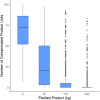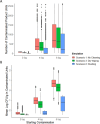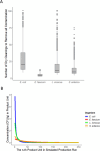A simulation model to quantify the efficacy of dry cleaning interventions on a contaminated milk powder line
- PMID: 40243318
- PMCID: PMC12093965
- DOI: 10.1128/aem.02086-24
A simulation model to quantify the efficacy of dry cleaning interventions on a contaminated milk powder line
Abstract
Outbreaks of Salmonella in low moisture foods have been caused by cross-contamination from the processing environment into product. We used Monte Carlo simulations to model the impact of hypothetical cross-contamination scenarios of Salmonella from production equipment into milk powder. Model outputs included the quantity and extent of the contaminated product from a production line. Outputs were used to compare the efficacy of cleaning interventions. Cross-contamination of potential dry cleaning surrogates was also modeled. Input parameters for the model included log reductions from wiping an inoculated surface with a dry towel and transfer coefficients from an inoculated surface to milk powder. After a 2-log CFU contamination breach (Salmonella introduced to an 8.4 cm2 stainless-steel surface on the processing line before production), the number of consumer-sized milk powder units (300 g) contaminated with Salmonella was 72 [24, 96] (median [p5, p95] across 1,000 simulation iterations). The average concentration of Salmonella within contaminated units was -2.33-log CFU/g [-2.46, -1.86]. Wiping the contaminated surface with a dry towel before the production of milk powder reduced the number of contaminated units to 26 [12, 64]. Flushing the contaminated surface with 150 kg of milk powder prior to milk powder production reduced the number of contaminated units to 0 [0, 41]. Flushing with 300 kg of milk powder further reduced the number of contaminated milk powder units to 0 [0, 16]. Enterococcus faecium resulted in a similar number of contaminated units (74 [44, 93]) compared with Salmonella (72 [24, 96]) after a 2-log CFU contamination breach.
Importance: This work demonstrates the utility of modeling as a decision support tool to (i) estimate Salmonella cross-contamination into product under different scenarios, (ii) compare different cleaning interventions, and (iii) help inform the selection of a Salmonella surrogate for cleaning validation studies. Risk models can describe the tradeoffs associated with different dry cleaning strategies in low moisture food environments. For example, the model presented in this study can estimate the differences in product contamination as a consequence of flushing a processing line with increasing quantities of material. Additionally, outputs from this model can be used to evaluate the risk of cross-contamination from a contaminated dry cleaning tool. Finally, comparing outputs from a simulation model is an alternative method for comparing Salmonella surrogates used in dry cleaning validation. Simulation model outputs (i.e., prevalence and concentration of contaminated units) may be more broadly interpretable than comparing transfer coefficients alone, enhancing decision support.
Keywords: Monte Carlo simulation; computer modeling; dry cleaning; dry sanitation; flushing; food-borne pathogens; low moisture food; milk powder.
Conflict of interest statement
The authors declare no conflict of interest.
Figures








Similar articles
-
Surface inoculation method impacts microbial reduction and transfer of Salmonella Enteritidis PT 30 and potential surrogates during dry sanitation.Int J Food Microbiol. 2023 Dec 2;406:110405. doi: 10.1016/j.ijfoodmicro.2023.110405. Epub 2023 Sep 18. Int J Food Microbiol. 2023. PMID: 37734279
-
Cross-contamination Risks in Dry Produce Packinghouses: Efficacy of Alcohol-based Sanitizers to Reduce Salmonella and Potential Surrogates on Relevant Surface Materials.J Food Prot. 2025 Feb 3;88(2):100443. doi: 10.1016/j.jfp.2024.100443. Epub 2024 Dec 27. J Food Prot. 2025. PMID: 39733795
-
Evaluation of Enterococcus faecium NRRL B-2354 as a surrogate for Salmonella enterica in milk powders at different storage times and temperatures.J Dairy Sci. 2021 Jan;104(1):198-210. doi: 10.3168/jds.2020-19190. Epub 2020 Nov 12. J Dairy Sci. 2021. PMID: 33189289
-
A review of food safety in low-moisture foods with current and potential dry-cleaning methods.J Food Sci. 2024 Feb;89(2):793-810. doi: 10.1111/1750-3841.16920. Epub 2024 Jan 14. J Food Sci. 2024. PMID: 38221802 Review.
-
Monte Carlo simulation of pathogen behavior during the sprout production process.Appl Environ Microbiol. 2005 Feb;71(2):746-53. doi: 10.1128/AEM.71.2.746-753.2005. Appl Environ Microbiol. 2005. PMID: 15691926 Free PMC article. Review.
References
-
- Belina D, Bohanan M, Cook D, Davidson C, Galer C, Heiman R, Herrling J, Kuehm J, Kedzierski D, Ruffie D, Thompson R, Tjornehoj D, Travis J, Stubbs T, Warren B. 2022. Framework for establishing hygienic separation in continuous dairy powder systems in the event of a pathogen positive in finished product. Innovation Center for U.S. Dairy.
-
- FDA . 2016. Food regulators seize adulterated milk products for food safety violations | FDA
-
- Jourdan-da Silva N, Fabre L, Robinson E, Fournet N, Nisavanh A, Bruyand M, Mailles A, Serre E, Ravel M, Guibert V, Issenhuth-Jeanjean S, Renaudat C, Tourdjman M, Septfons A, Le Hello S. 2018. In Ongoing nationwide outbreak of Salmonella agona associated with internationally distributed infant milk products. France. - PMC - PubMed
-
- CDC . 2024. Cronobacter outbreak linked to powdered infant formula | cronobacter infection | CDC
MeSH terms
Substances
LinkOut - more resources
Full Text Sources
Medical
Research Materials
Miscellaneous

